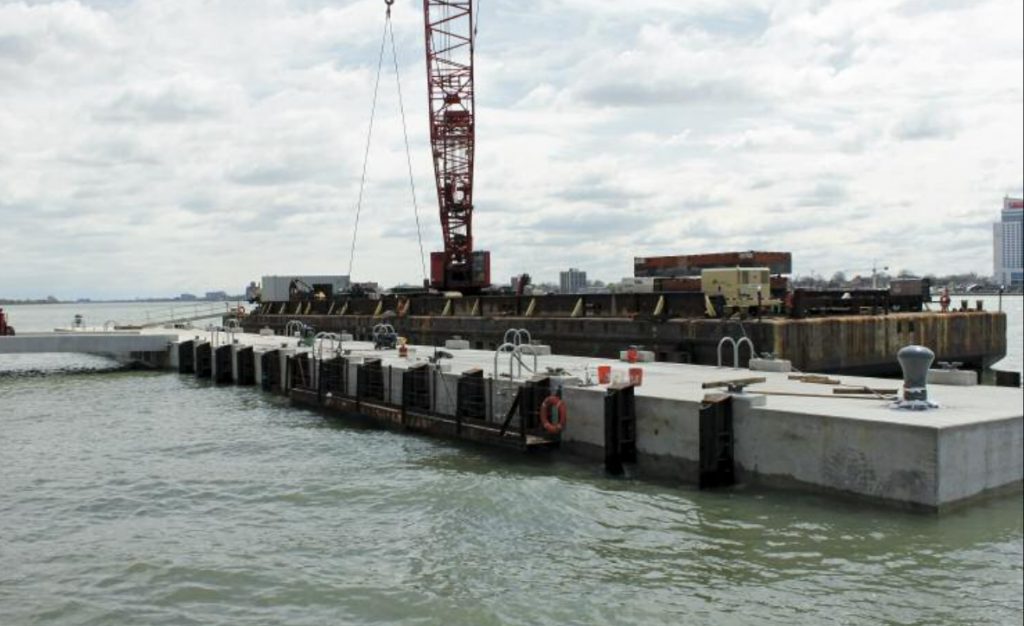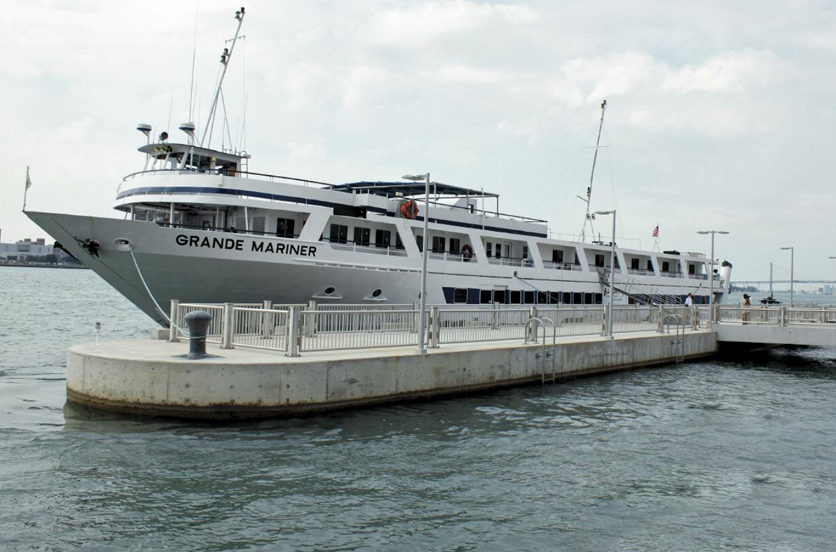The Detroit/Wayne County Port Authority Public Dock and Terminal
By Roy Jones, Contributing Editor
October 11, 2012
The Grand Mariner, a 184-foot cruise ship from Cleveland, and its 40 passengers arrived at the new Detroit/Wayne County Port Authority Public Dock and Terminal (DWCPA) in mid-July 2011, making it the first large cruise ship to use the long-awaited dock and facility. While the passengers spent the day visiting Detroit area attractions, a ribbon-cutting ceremony took place in front of the cruise ship and the new $22 million facility. Among the dignitaries who took part in the ceremony were Detroit Mayor Dave Bing, U.S. Senator Carl Levin, U.S. Rep. Hansen Clark, and Wayne County Executive Robert Ficano. Senator Levin was a driving force behind this project, which received federal funds and grants and was years in the making.
The port, a 1.2 acre site, is located between Hart Plaza and the Renaissance Center along Detroit’s revitalized riverfront area. The 21,000-square-foot Port Authority Terminal Building overlooks the 250-foot offshore Port Authority Wharf and the three-mile riverwalk between Cobo Hall and Rivard Street. The project is the key to hopes of luring Great Lakes cruise ships, dinner cruisers, tour boats, tall ships and other vessels which will, in turn, have a direct economic and positive impact on the city of Detroit.“We have been working hard to restore Detroit as a destination for the Great Lakes cruising industry,” said John Jamian, president and CEO of the DWCPA,“This port becomes an essential piece of a continuation of the rebuilding of this city.”
Detroit was one of the only cities with a major port to not have a modern public dock and passenger terminal. Without a dock, the Great Lakes cruising industry has been dormant in Detroit since 1967. This industry has reemerged as a growing market and is having a strong economic impact on cities throughout the Great Lakes region, including Chicago, Cleveland, Toledo, and Windsor. Says Jamian, “The new public dock and terminal will provide residents and visitors direct access to the river. It is a vital part of the overall vision for a transformed Detroit Riverfront and a contender in the Great Lakes tourism market.”In 2012,there will be an estimated 14 visits by Great Lakes cruise ships.
Offshore Wharf Challenges
The construction of the new offshore wharf was faced with many obstacles. In simple terms, the water needs to be deep enough to accommodate cruise ships. A 200 x 30-foot steel pile-supported structure would be needed to reach 40 feet into the river.
The site’s shoreline was comprised of the 40-foot-wide Bates Street combined sewer overflow (CSO) structure, a 112-foot length of unimproved shoreline, and a 368-foot-long wharf thought to be 32 feet wide. The proposed terminal building area was located north of the wharf and west of an existing onestory brick pump house. Known impediments to development were a CSO outfall and the Detroit-Windsor Passenger Car Tunnel (DWT) within and below the eastern portion of the existing wharf, and a 36-inch raw water force main traversing the proposed building site. The initial site investigation revealed the presence of an abandoned water intake and significant structural deterioration of the eastern portion of the existing wharf, rendering it unusable for a deep water port. The western portion of the wharf was found to extend up to 57 feet inland and significantly reduced the proposed terminal building area. In addition to the force main known to bisect the proposed terminal site, buried concrete vaults located east of the Bates Outfall and wharf counterfort elements extending into the building footprint impacted building space planning and impeded building foundation construction. To further complicate development at this site, local water, gas, and electric thought to exist under the adjacent street had been either abandoned or removed as part of other development projects in the vicinity.
Faced with the discovery of the deteriorated condition of the existing wharf, an unanticipated reduction in the land available to site the building, and the complex interaction of existing below grade structures and site utilities,the DWCPA had to decide whether to abandon the project or move forward. The project team assisted the DWCPA with development of a new conceptual plan consistent with the original vision. Working together, the Owner’s Representative John Kerr, director of economic development of DWCPA; construction manager White/Braun LLC; program managers SDG Associates; architects Hamilton Anderson Associates; and engineers HH Engineering, NTH Consultants, LTD, Peter Basso & Associates, Shymanski Associates, and Tucker Young Jackson and Tull, revised the project plan to include a new offshore wharf, repair and re-commission the existing wharf to a new use, and overcame the impediments to building construction.

The project team worked closely with the Owner’s Representative John Kerr and the DWCPA to address the concerns of the owners of utilities that cross the site and other stakeholders for this project including: the Detroit Water and Sewerage Department; the Detroit Wayne Joint Building Authority, the Detroit-Windsor Tunnel, the GM Renaissance Center, and the Riverfront Conservancy
Detroit’s Engineering, Public Lighting, and Water and Sewerage Departments allowed the project team to research their historical archives.The documents obtained from those archives and the DWT enabled the creation of a decade-by-decade site development chronology starting in the early 1900s, that was used to target onsite investigations, confirm the locations and condition of below-grade elements on the site, understand the basis of design for the existing wharf, understand the complex interaction of utilities built within and shoreside of the wharf, understand the impact of the Detroit-Windsor Tunnel (1930s) and the Raw Water Intake and Pump Station construction on the existing wharf, perform the analysis of the wharf in its present deteriorated state, and select repair and stabilization methods.
The existing wharf was constructed in 1921 and consists of a timber pile-supported concrete deck with a concrete bulkhead on the out-shore side to retain approximately four feet of miscellaneous fill soils. Integral to the structure of the eastern portion of the wharf are the Randolph Street Outfall, and the Raw Water Intake and Pumping Station that service the Renaissance Center and the City-County Building. In addition,the timber piling at the eastern end of the wharf is believed to have been cut and cast into the crown of the Detroit-Windsor Tunnel when it was mined beneath the wharf in 1930. Integral to the structure of the western portion of the wharf is a concrete bulkhead supported on timber piling constructed pre-1910.This former dock structure is restrained laterally by concrete beams extending up to 22 feet landward of the wharf structure into the terminal building footprint area.
Condition assessments of the existing structures indicated that the wharf concrete deck and timber piles were generally in good condition; however several piles over the Detroit-Windsor Tunnel had section loss at the underside of the wharf deck. In addition, the out-shore face of the concrete bulkhead had suffered significant freeze-thaw damage, and the horizontal steel tie rods that provide lateral restraint for the eastern half of the wharf were either missing or corroded.
The age and condition of the existing wharf, combined with recent development north of the wharf that restricted access for repair of horizontal restraint elements precluded use of the existing wharf as a deep-water port.Replacement with a newer structure was not an option due to the presence of the DWT beneath the existing wharf. As a result, repair options were limited to repair of piles in contact with the tunnel, riprap placement to stabilize the east wharf slope, and selective demolition/repair of the shoreline bulkhead.

